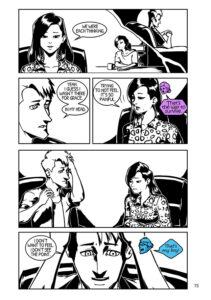I Do, I Don’t
Reviewed by Will Morgan 07-Nov-23
A self-help book in Graphic Novel format, I Do, I Don’t admirably summarizes and contextualizes complex concepts for everyday use.
 By Chandrama Anderson and Nur Jaffar G. Latip (Soaring Penguin)
By Chandrama Anderson and Nur Jaffar G. Latip (Soaring Penguin)
Not all of Soaring Penguin’s experiments have been successful in the past, but one of the things they’ve never been afraid to do is push their boundaries, and this 200+ page graphic novel guide to relationship therapy is a step quite different from anything they’ve taken before.
It’s also quite effective.
Our point of view couple, Ben and Grace, are entering therapy because of their marital difficulties—though the preface takes pains to state that ‘relationship’ can be substituted for ‘marriage’, and that the techniques are applicable to any couple regardless of gender. Following them through the therapeutic process, they, and we, are introduced chapter by chapter to different tools for analysing, understanding, and eventually redirecting the relationship dynamic. Each chapter is followed up by a ‘homework’ sheet of exercises by which the reader can explore their own relationship.
 Speaking from my own distant background as a therapist—though not a relationship specialist—I can attest to the efficacy of the techniques herein. Although some readers may balk at the terminology, it is clearly explained and contextualised as a shorthand guide to augmenting and understanding the therapeutic process.
Speaking from my own distant background as a therapist—though not a relationship specialist—I can attest to the efficacy of the techniques herein. Although some readers may balk at the terminology, it is clearly explained and contextualised as a shorthand guide to augmenting and understanding the therapeutic process.
Chandrama Anderson’s script does an admirable job of breaking a complex web of clinical concepts down into readily comprehensible segments. The artwork of Nur Jaffar G. Latip is more difficult to assess, owing to the necessarily static format of the content; he gets us from point A to point B and onwards without any jarring failings, but doesn’t really get a chance to cut loose.
 My only criticism is something one doesn’t generally, if it’s done well, even notice; the lettering. The balloons tend to be small and cramped, with a narrower font than one is accustomed to. It’s legible, but considerably less reader-friendly than the norm. For a book whose primary intended audience is ‘civilians’—people not intimately familiar with the comics format—and in which clarity and accessibility is crucial, having the readers pausing to squint and ponder seems rather… counter-productive.
My only criticism is something one doesn’t generally, if it’s done well, even notice; the lettering. The balloons tend to be small and cramped, with a narrower font than one is accustomed to. It’s legible, but considerably less reader-friendly than the norm. For a book whose primary intended audience is ‘civilians’—people not intimately familiar with the comics format—and in which clarity and accessibility is crucial, having the readers pausing to squint and ponder seems rather… counter-productive.
In every other respect, however, it’s an intelligent and insightful read, and while obviously intended as a supplement to therapy rather than a substitute for it, it could nevertheless be helpful for people who don’t have access to, or simply can’t afford, frequent consultations.
Tags: Relationships, Self-help, Therapy